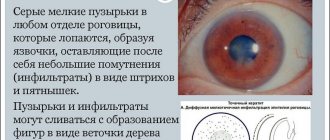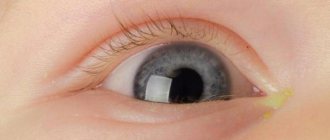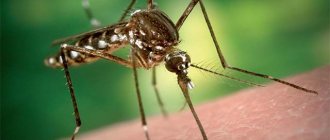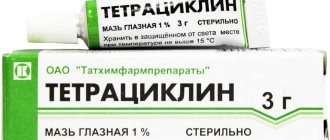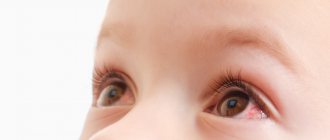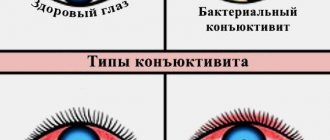Causes
A variety of reasons can lead to red eyes in a child. The most common ones include:
- overstrain, fatigue of the visual organ;
- penetration of a foreign object into the eyes;
- injury to the mucous membrane of the organ;
- conjunctivitis in children;
- allergy;
- inflammation of the choroid of the eye;
- blepharitis;
- glaucoma;
- vegetative-vascular dystonia;
- blockage of tear ducts.
If you are interested in dacryocystitis in newborns, you can find information here.
Conjunctivitis in children
Possible diseases
If a child develops red circles under the eyes or the eyes are purulent, this may be a symptom of a certain illness, the treatment of which must be treated as urgently as possible.
Conjunctivitis
They are the most common eye diseases in children. They differ according to the type of pathogen.
Adenoviral
This disease is one of the most common and contagious. Initially, the baby’s appetite decreases, the temperature rises and severe pain in the head is felt. Afterwards, the temperature drops, and general health returns to normal. Then the temperature rises again, the eyes turn red, but there is not much discharge from them. The baby has swollen lymph nodes, a runny nose and a sore throat. If there is a viral infection, then the child’s visual organ sensitivity decreases, but there is no burning sensation or other unpleasant symptoms.
Herpetic
This pathological process can be recognized by the presence of bubbles that are concentrated on the edges of the eyelids and near the eyes. In addition, the baby has a pronounced form of photophobia and copious secretion of tear fluid.
Pneumococcal and staphylococcal
The peculiarity of these ailments is that they have an acute onset. Initially, redness and suppuration are observed on one visual organ, and then spread to another. Moreover, the eye is very red, and purulent discharge is literally flowing.
Gonococcal
This disease makes itself felt 2-3 days after the birth of the child. Its development is influenced by infection, which can enter the baby’s body through the birth canal or care items. The peculiarity of gonococcal conjunctivitis is that the child’s eyelid swells greatly, as a result of which the eye practically does not open. The baby also produces copious amounts of mucous discharge. The disease is very dangerous; if timely treatment is not started, it can lead to the development of inflammation of the entire visual organ.
Diphtheria
Accompanied by severe swelling of the eye and the presence of films. If you begin to remove them, blood begins to be released, and then scars form. The films themselves will come off in 7-10 days.
Allergic
This form of conjunctivitis occurs in children mainly in early spring. Then the infectious process affects both eyes. Allergic conjunctivitis is very often diagnosed in boys. The baby is bothered by severe itching.
Trachoma
This is an infectious process that affects the eyes and has a chronic form. Chlamydia can affect its development. The danger of the disease is that without adequate therapy, the baby may develop blindness. Today, this disease is diagnosed extremely rarely. The pathogen is transmitted through the hands, hygiene items and clothing of an already infected person. Very rarely the disease is transmitted through flies.
The duration of the incubation period will be 8-16 days. Two eyes are affected at once.
At an early stage, redness of the conjunctiva occurs. But with an advanced form of trachoma, clouding of the cornea and inversion of the eyelids are characteristic.
The following stages of development of the pathological process are distinguished:
- First stage . It is characterized by inflammation with the formation of large follicles.
- Second stage. The follicles disintegrate, they merge and form scars.
- Third stage. Progression of scar formation in the conjunctiva is observed.
- Fourth stage. The scarring process is coming to an end.
Dacryocystitis
This is a disease characterized by an inflammatory process that occurs in the lacrimal sac. The formation of the disease occurs due to stagnation of tear fluid in the lacrimal sac in the presence of an infectious process. The fluid stagnates due to impaired patency of the flow, which is the connecting element between the nasal cavity and the lacrimal sac.
The development of inflammation in the lacrimal apparatus in a child is congenital. But in adults, the disease develops due to swelling of the tissues adjacent to the lacrimal canal.
The development of such symptoms is influenced by respiratory infections and chronic inflammation of the nasal mucosa.
Dacryocystitis can be divided into the following types:
- viral;
- microbial;
- parasitic.
The following symptoms are characteristic of dacryocystitis:
- copious secretion of tear fluid;
- swelling in the area of the lacrimal sac;
- mucous-purulent discharge from the lacrimal canal;
- redness of the lacrimal caruncle, conjunctiva, eyelids and semilunar fold;
- the formation of blepharitis, conjunctivitis, keratitis or purulent corneal ulcer, if the disease is chronic;
- narrowing of the palpebral fissure if the disease occurs in an acute form;
- chills, fever, headache. in the acute form of the pathological process.
If timely treatment is not started, this leads to the subsequent development of an external or internal fistula. Purulent mucus regularly comes out of it. Even the lack of treatment leads to the formation of phlegmon of the orbit.
Barley
This is an eye disease characterized by swelling of the eyelid. The pathological process occurs as a result of infection in the eyelash follicles. In medical terminology, barley is called Hordeolum.
You can find out about the first signs of stye on the eye in the article.
There are the following types of barley:
- External . This type is the most common. It is focused on the outer part of the eyelid. In appearance it looks like abscesses.
- Internal . It forms on the inner surface of the eyelid. The cause of its development is infection of the meibomian glands.
Types of barley
For information on the treatment of meibomitis, see here.
Barley can be recognized by the following symptoms:
- painful sensations;
- redness and swelling of the eyelid;
- increased secretion of tear fluid;
- presence of a foreign object in the eye;
The development of barley is influenced by staphylococcal infection or blepharitis.
How to treat pus in a child's eyes
It is not recommended to treat a 1-12 month old child on your own. The specialist must take into account the individual characteristics of the baby before prescribing effective therapy, especially if the cause of suppuration is viral or bacterial infections. If purulent processes develop in the spring, then most likely it is allergic conjunctivitis, so antihistamines are needed. Infectious pathologies are treated with antibacterial ointments, and if the eyes of a month-old baby are festering due to dacryocystitis, then only a special massage will help.
First aid
It is not always possible to see a doctor, so if the eyeball is red, runny, swelling of the mucous membrane and purulent discharge from the child’s eye, it is necessary to provide him with first aid:
- If after sleep the baby cannot open the eyelid, the crusts need to be softened. To do this, a cotton swab should be soaked in a warm 0.2% solution of furatsilin, a weak solution of potassium permanganate, weak tea or herbal decoction. Irrigation stimulates the opening of the optic ducts.
- After washing the eye, you need to drip it with a 10% solution of albucid. To do this, the lower eyelid should be pulled back and the pipette should be directed to the outer corner.
- Warm herbal infusions and tea for rinsing can be used every 2 hours. Use drops for instillation 4-6 times a day.
- It is contraindicated to further treat the baby on your own. Treatment with antibiotics without a doctor's prescription is prohibited.
- How to play checkers
- Uterine fibroids: treatment with folk remedies
- Meatballs in the oven with gravy: recipes
How to wash a child's eyes
Treating a child is a responsible and serious matter. If pus begins to accumulate in the baby’s eyes, dried chamomile or calendula flowers are suitable for washing them. Infusions are easy to prepare. To do this, put 1.5 tbsp in a 200 ml bowl. l. chamomile, calendula or a mixture of plants purchased at the pharmacy. Then fill it with boiling water to the brim, cover with a lid and let it brew for two hours. The temperature of chamomile decoction for instillation into a child’s eyes should not exceed 37 degrees.
Drug treatment
Suppuration of the eyes requires immediate treatment. Initially, the doctor prescribes drug therapy, which is based on the causes of the pathology. If the medications do not give a positive result, and the child’s eyes constantly fester, then surgical intervention is required. For conjunctivitis, the doctor may prescribe the following medications:
- Acyclovir (tablets). The drug helps with viral infections caused by herpes. The recommended dose for children over 2 years of age is 200 mg 5 times a day for 5 days. In case of overdose, adverse reactions are possible in the form of nausea, vomiting, headaches, and confusion.
- Levomycetin (alcohol solution). A topical antimicrobial that is used for bacterial eye infections. Children over 1 year of age are prescribed 2-3 drops 1-2 times a day. The doctor prescribes the duration of the course individually. Sometimes allergic reactions develop in children in the form of eye burning and itching.
Drops for pus in the eyes
Drops are prescribed to children for inflammation, when the eyes are watery and sticky due to pus flowing from them. The drugs are produced in the form of a solution placed in a special dropper bottle. Depending on the pathogen, eye drops may belong to the antibacterial or antiviral group. Most drugs have anti-inflammatory, antiallergic, analgesic and immunomodulatory properties. Popular drugs for children:
- Torbex. Broad-spectrum antibiotic of the aminoglycoside group. Prescribed for the treatment of conjunctivitis for children over 1 year of age. Rarely used for infants. Recommended dosage is 1 drop 5 times a day. Duration of treatment – 1 week. If the dose is exceeded, there is a danger of deterioration in kidney function and the development of muscle paralysis.
- Phloxal. Antibacterial drops that provide a lasting and rapid therapeutic effect. Children's dosage – 1 drop every 6 hours for 14 days. Treatment should not be interrupted after symptoms disappear.
Eye ointments
There are many ointments for the treatment of eye diseases. They are used depending on the causative agent of the disease. It is easy to find non-steroidal antimicrobial, steroidal hormonal, antihistamine and combined topical medications on sale. The following drugs are most often prescribed for the treatment of childhood eye diseases:
- Florenal ointment. Suppresses the proliferation of viruses that cause damage to mucous membranes. Apply the ointment behind the eyelid 2 times a day, morning and evening. The duration of treatment depends on the degree of infection by the virus. In advanced stages of adenovirus, the ointment is used for 1-2 months. The drug should not be used by children with hypersensitivity to its components.
- Tetracycline ointment. A broad-spectrum antibiotic prescribed for children over 8 years of age. The recommended dosage for eye infections is to apply the ointment under the lower eyelid 3 to 5 times a day. Duration of use – from 3 to 30 days. The ointment is contraindicated for use in cases of abnormal blood composition, liver and/or kidney dysfunction.
Special massage
For dacryocystitis, ointments, drops and eye washes will not bring a therapeutic result. To improve the condition, you must first remove the film using a special massage, the technique of which should be shown to the parents by a doctor. Before performing the procedure, you should wash your hands thoroughly and ensure that your nails are trimmed. Using your finger up and down, you should massage the inside of your baby's eye very gently. 6-10 movements are done in one session. If there is a lot of pus coming out of the lacrimal sac, it means that the procedure is being performed correctly.
Diagnostic methods
To make an accurate diagnosis, the child must be shown to an ophthalmologist. He will first ask parents about the existing symptoms, as well as about factors that can lead to the development of the disease. It is also important to know the characteristics of the clinical picture - duration and severity, the presence of additional diseases. The child may have had previous eye surgery or an injury. The doctor must also perform differential diagnosis. He will take a scraping or swab from the conjunctiva of the eye to determine the infection. After collecting all the information, the doctor begins an examination and makes a diagnosis based on the available data.
Treatment
Since various diseases can affect the redness and purulence of a baby’s eye, treatment is individual in nature.
Treatment should only be carried out under the supervision of an ophthalmologist. If you ignore therapy, this is fraught with the development of severe complications.
Treatment of conjunctivitis
When carrying out therapeutic measures to eliminate conjunctivitis, patients and everyone around them must wash their hands and adhere to the rules of personal hygiene. Therapeutic measures are prescribed taking into account the type of pathological process.
In the treatment regimen, the doctor must include medicinal components that have a local effect. This should include antiviral drops and ointments, interferons. If a child is diagnosed with viral conjunctivitis, then Oftalmoferon eye drops can effectively treat it. To relieve unpleasant symptoms, it is necessary to apply warm compresses and drops of artificial tears.
When treating a child, it is important to restore his immunity, since viral conjunctivitis in children has an advantage due to the fact that it is weak. To increase the body's defenses, it is necessary to use multivitamin complexes, microelements and herbal preparations to improve immunity.
If the eye of a 3-year-old child is festering, then look for information in the material.
Viral conjunctivitis cannot be ignored; it requires immediate treatment, since inflammation of the mucous organs of vision can spread to the rest of the tissues of the eye, as well as to the cornea. This is fraught with the development of white spots on the cornea, which will subsequently lead to blindness. Removing these stains is a rather lengthy and complex process.
When the cause of conjunctivitis is bacteria, the doctor must prescribe drops or ointments with an antibacterial effect in the treatment regimen. During the day, the child should use eye drops, as ointments reduce visual acuity. It is best to use them before bed.
To cure bacterial conjunctivitis, it is necessary to use fluoroquinolone antibiotics. These drugs should be used provided that chlamydial and gonococcal infections have not been detected. There are situations when some microorganisms have strong immunity to antibiotics. Then the doctor conducts a bacteriological culture and establishes sensitivity to antibiotics in order to prescribe another drug.
For the treatment of gonoblennorrhea, drugs of general and local influence are used. The most commonly prescribed drugs are sulfonamides and antibiotics, which include:
- Ceftriaxone;
- Ciprofloxacin drops;
- Bacitracin.
Among eye drops, the following are considered very effective:
- Okacil;
- Phloxal;
- Penicillin.
Floxal eye drops instructions for use here.
Additionally, the child is prescribed eye rinsing with a solution of boric acid. You can relieve unpleasant symptoms with a cold compress and artificial tear drops.
Before moving on to treatment of this form of conjunctivitis, it is necessary to understand what caused the allergy to develop.
When it is not possible to exclude contact with the allergen, the doctor prescribes non-steroidal anti-inflammatory or antihistamine medications.
Treatment of trachoma
The sooner treatment for trachoma is started, the less the cornea and conjunctiva will suffer.
Most often, as a result of long-term treatment, children develop a lot of scars on the mucous membrane of the eyes. They lead to curvature of the cartilage, inversion of the eyelids and incorrect position of the eyelashes.
For treatment, the doctor may prescribe ointments and solutions with an antibacterial effect. Effective ones include:
- Erythromycin;
- Tetracycline;
- Olethetrin.
They may also prescribe antibiotics - Sulfapyridazine sodium and Etazol.
You can learn how to use tetracycline eye ointment on your own.
If the disease is severe, there is deformation of the eyelids and clouding of the cornea, then surgical intervention is performed. If the disease cannot be cured, then a purulent corneal ulcer and dry eye syndrome develop.
Treatment of dacryocystitis
Before proceeding to treatment of this disease, it is necessary to soak the infiltrate. The patient is given systemic vitamin therapy and UHF treatment. It will also be necessary to open the abscess if the child has fluctuation. The resulting wound should be treated with antiseptics:
- Furacilin;
- Dioxidine;
- Hydrogen peroxide.
The following eye drops and ointments are also prescribed:
- Levomycetin;
- Gentamicin;
- Sulfacyl sodium;
- Miramistin;
- Erythromycin ointment;
- Tetracycline ointment,
- Phloxal.
Price from 80 rub.
Treatment also requires systemic antibacterial therapy, during which drugs with a wide range of effects are used:
- Cephalosporins;
- Aminoglycosides;
- Penicillins.
Treatment of barley
To cure stye, you need to make warm compresses and apply them to the area of the affected eye. Carry out such actions 3-4 times a day until relief occurs.
Drug treatment includes ointments and drops based on sulfonamides. In severe cases of the pathological process, surgery is necessary. It is done when the stye becomes large and its treatment is ineffective.
Traditional methods
Traditional methods of therapy act as auxiliary treatment. They should only be used in addition to basic medications. They do not eliminate the cause of the pathological process, but simply help cope with unpleasant symptoms. For these purposes, the following recipes are considered effective:
- Garden dill herb is poured with boiling water (100 g per 200 ml). Leave it for an hour, then filter it, and use the resulting infusion for rinsing.
- Pour boiling water over rose petals or cornflower flowers (100 g per 200 ml). Leave for 30 minutes, filter and use for rinsing.
- Dilute aloe juice with water in a ratio of 1:10. Use it to wash your eyes 3 times a day.
- To relieve unpleasant symptoms, you can make warm potato compresses at night. Grate it, and then place the pulp on gauze, and place it on the eye.
- To relieve redness, you can use homemade cottage cheese. Place it in a warm napkin and apply it to your closed eyes.
- Take 100 g rosehip petal and 200 ml water. Combine these components and simmer them on fire for 5 hours. The filtered and cooled broth is used for lotions.
- Take 60 g of herbs and chamomile flowers, pour 200 ml of hot water. Leave for 2 hours, covering the container with a lid. Filter and apply lotions. To do this, dip a cotton pad into the solution and then place it on your eyes.
- Take 40 g of calendula, pour 200 ml of boiling water. Leave for 20 minutes, filter and use the decoction for lotions. Calendula tincture, which you can buy at a pharmacy, is also effective. Before use, dilute it with water in a ratio of 1:10. You can use calendula ointment. To obtain it, you need to take the tincture and any vegetable oil in a ratio of 1:4.
What to do?
The first surgical treatment of the wound is used if there is a violation of the integrity of the skin. If necessary, they resort to excision of crushed tissue, and then sutures are made. Antiseptic and antibacterial drops are used to treat damage to the skin of the eye. After penetration of fragments, the conjunctival cavity is washed with a jet.
If the organ of vision is susceptible to blunt mechanical damage, it is necessary to maintain rest, apply a special binocular bandage to the eyelids, and instill atropine and pilocarpine.
In order for rapid resorption of hemorrhages to occur, it is necessary to use electrophoresis, as well as autohemotherapy; injections of dionin will help. Surgical interventions are necessary when tissue detachment is detected.
Barley in a baby
One of the acute inflammations of the hair follicle is stye. The disease occurs not only in adults, but also affects children. At the first stage, the baby's eyelid becomes covered with a slight swelling, which begins to hurt.
The skin in this area turns red and swells. The child begins to scratch the sore spot.
After some time, an abscess appears from the swelling, with a white crust or top. The opening of the stye occurs after the increase in size.
Symptoms should be observed for several days; if they do not disappear on their own, you should consult a doctor for help.
For what reasons does the disease appear?
Staphylococcus bacillus is the first causative agent of the disease called barley.
A child becomes ill due to the following factors:
- due to weak immunity;
- influence of acclimatization;
- after hypothermia;
- from hypo- and vitamin deficiency;
- it appears after the change of seasons;
- often chronic diseases, such as diabetes mellitus or the appearance of inflammatory diseases of the ENT organs.
How to cure?
Basics of treatment:
- Maintaining good personal hygiene is one of the first cures. The child should not rub his eyes with dirty hands; after washing, the baby should have his own towel. Dry heat will be needed at the initial stage of the disease.
- Antibacterial eye drops are necessary to treat stye. There are special ointments that also help cope with the disease.
- Piercing the tear can only be done by a doctor; he can make an incision. After this, the contents will come out of the inflamed sac.
- To prevent barley from reappearing , it is necessary to strengthen the immune system.
What to do if a child’s eye becomes purulent due to a cold?
If the organs of vision begin to fester due to ARVI, the situation is serious. Antibacterial drugs are used to eliminate purulent formations. Medicines are used in the form of ointments, sprays, and drops. The choice of medications should only be made by a doctor.
Prevention
To prevent the development of inflammatory processes in the eye, it is necessary to carefully monitor personal hygiene. Do not touch your eyes with dirty hands.
Children who use contact lenses must especially adhere to sanitary and hygienic standards, since their hands come into contact with the mucous membrane of the visual organ. Wash your hands thoroughly with soap.
When the inflammatory process has already affected the mucous membrane of the eye, you should not delay treatment and use home remedies yourself. This can lead to the development of serious complications, including corneal damage. To get rid of such consequences, it is necessary to spend more than one month, or even a year.
Prevention of gonolonnorrhea in newborns requires women to be thoroughly examined for the presence of gonococcal infection during pregnancy and begin timely treatment if it is detected. As soon as the baby is born, 1 drop of sodium sulfacyl solution is dripped into his conjunctival sac. This is an excellent prevention against the disease.
Causes and treatment of foggy eyes
Tobradex eye drops with instructions are described in this article.
Color blindness test https://eyesdocs.ru/proverka-zreniya/tablicy/test-na-cvetovuyu-slepotu-kak-primenit-v-domashnix-usloviyax.html
Folk remedies
When using them, you should understand that they cannot replace full treatment with modern drugs, but are, first of all, auxiliary means. Before using them, you should definitely consult your pediatrician. The presence of plant components in drugs increases the risk of allergies.
To wash a festering eye, a decoction of medicinal chamomile or regular black tea is suitable. Any of the previously mentioned remedies must be used to wipe the affected visual organ. It is important to do this quite often - from 4 to 8 times a day. It is most convenient to carry out the procedure using a cotton swab or disk. A bandage folded several times will also work. It must be sterile. It is effective, in turn, to wash the eye from a pipette.
The drugs mentioned above:
- significantly accelerate the release of pus;
- gently disinfect inflamed areas;
- stop the problem.
Prepare chamomile decoction as follows:
- 10 grams of chamomile pour a glass of boiling water;
- bring to a boil and keep on low heat for about 5 minutes;
- the finished product is filtered.
Washing the eye with a tea bag wrapped in a bandage is also suitable. It should not be hot under any circumstances.
Dill compress has proven its effectiveness over many years. A decoction is prepared from fresh twigs. In their absence, dry collection will do. If seeds are used, they will need no more than 2 grams per 150 milliliters of water. You need more branches - about 5 grams.
The raw materials are boiled in water for 10 minutes, the broth is filtered. Two tampons of the required size are made from gauze. They are moistened with the drug and placed on closed eyes. To enhance the effect, you can put a towel on top. The compress is removed after 8-15 minutes.
Lotions based on clover and cornflower will also be useful. Reviews indicate that this drug is effective even in very advanced cases when nothing else helps.
You need to take 5 grams of each medicinal plant. They are crushed and steamed with a glass of boiling water. You need to insist for about 3 hours. The strained medicine is used as follows:
- small balls are rolled out of cotton wool;
- moistened in the infusion;
- apply to the eyes for half a minute.
The procedure is repeated 2 to 6 times a day.
conclusions
Redness and discharge of pus from the eyes of a child is a very alarming symptom. Parents should not delay going to the hospital, because this could be a symptom of some disease. Timely treatment will not only help you get rid of unpleasant symptoms, but also prevent complications such as visual impairment. Do not forget that exercises for improving vision with farsightedness are very useful.
Many people believe that strabismus in children is only a cosmetic defect, but in reality it is a rather dangerous pathology. If the problem is not corrected before the age of seven, the child’s vision may deteriorate significantly in the future.
First aid
What to do if a child’s eye is festering, but there is no way to see a doctor?
In this case, parents should know how and with what they can help their baby at home:
- After a long sleep, the pus in the eyes dries out, and the child has difficulty opening his eyelids. The crusts must be softened by wetting the eyes using tampons with a 0.2% furatsilin solution, weak tea leaves, chamomile or calendula decoction. Soaked crusts are carefully removed.
- The solution used should have a temperature of 37 degrees.
- Each eye should be washed . In this case, movements during the procedure should be from the outer edge of the eyelids to the nose .
- After washing, a solution is dropped into the eye . For children under two years of age, 10% albucid is used. If the child is older, then 20% albucid can be instilled. Apply 1-2 drops to each eye. To do this, the lower eyelid is pulled back and the pipette is directed to the outer corner. You cannot touch the mucous membrane with a pipette, otherwise you can get an infection.
It is recommended to use weak tea and herbal infusions every two hours . Treatment drops are used four to six times a day .
Before each procedure, parents must wash their hands with soap. Only well-washed pipettes and sterile swabs should be used. You can make them from sterile cotton wool purchased at the pharmacy.
Continuing to treat your eyes on your own is contraindicated if:
- a blister appeared on the upper eyelid;
- the baby began to see worse;
- the child complains of pain in the eyes;
- there are symptoms of photophobia;
- the eyes fester for more than two days, and there is no improvement with help.
It is not recommended to independently treat the eyes of children who are under one year old.
